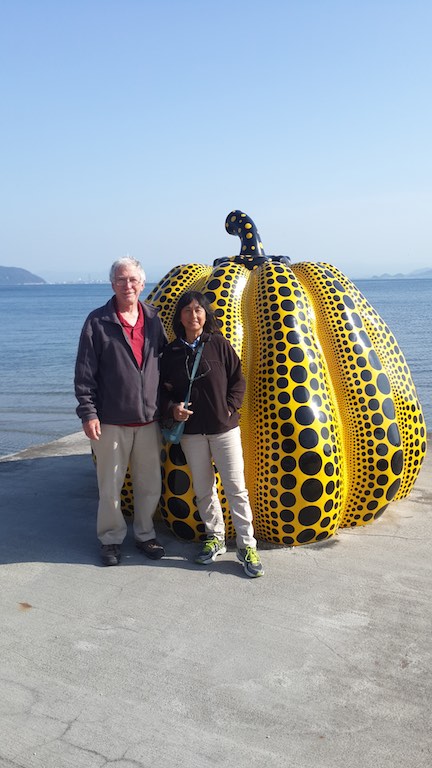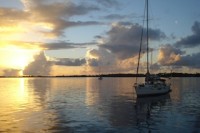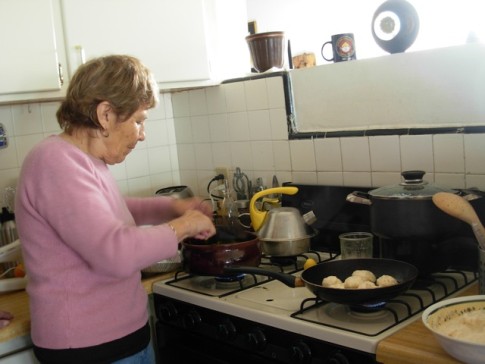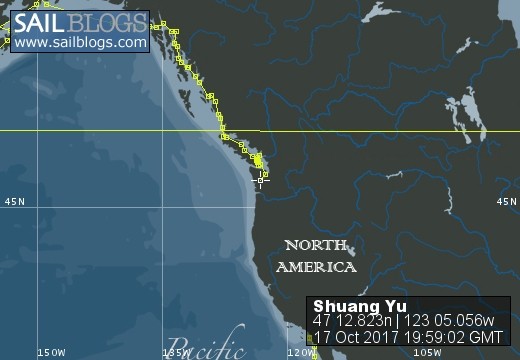
Joy of Cruising
17 October 2017 | Boat position at Shelton: 47°12.82’N; 123°05.01’W
16 October 2017 | Boat position at Shilshole Marina: 47°40.65’N; 122°24.59’W
15 October 2017 | Boat position at Friday Harbor: 48°32.20’N; 123°0.59’W
27 September 2017 | Boat position on Granville Island: 49°16.35’N; 123°08.24’W
26 September 2017 | Boat position on Granville Island: 49°16.35’N; 123°08.24’W
22 July 2017 | Boat position at Granville Island: 49°16.35’N; 123°08.24’W
21 July 2017 | Boat position at Vancouver Rowing Club, Canada: 49°17.77’N; 123°07.85’W
20 July 2017 | Boat position at the Vancouver Rowing Club, Canada: 49°17.77’N; 123°07.85’W
19 July 2017 | Boat position at the Vancouver Rowing Club: 49°17.77’N; 123°07.85’W
18 July 2017 | Boat position in Active Pass: 48°51.64’N; 123°18.54’W
17 July 2017 | Boat position at Otter Cove, Pender Island, Canada: 48°47.84’N; 123°18.51’W
15 July 2017 | Boat position at Port Bedwell, Pender Island, Canada: 48 44.97'N; 123 13.97'W
14 July 2017 | Boat position at RVYC: 48 27.19'N; 123 17.73'W
13 July 2017 | Boat position at RVYC: 48 27.19'N; 123 17.73'W
12 July 2017 | Boat position at SNSYC: 48 40.44'N; 123 25.02'W
12 July 2017 | Boat position at SNSYC: 48 40.44'N; 123 25.02'W
11 July 2017 | Boat position at SNSYC: 48 40.44'N; 123 25.02'W
10 July 2017 | Boat position at Ganges: 48 51.00'N; 123 29.53'W
09 July 2017 | Boat position at Ganges: 48 51.00'N; 123 29.53'W
08 July 2017 | Boat position at Montague Harbour: 48 53.63'N; 123 24.03'W
Naoshima 1
20 April 2016 | Boat position at Miyanoura Port, Noashima, Japan: 34 27.453'N; 133 58.410'E
Pam Lau

Picture: Ted and Pam standing in front a piece of artwork, the yellow pumpkin.
We started sailing around 6:00 a.m. from Shodoshima because the current was with us at that time. There is not a great distance between those two islands, only about twenty nautical miles, so we arrived around 9:00 am. Noashima is a tourist destination because of its famous art projects and museums which are located throughout the eastern part of the island. Three years ago we had visited the island with the 2013 Setouchi Yacht Rally but we were only there for a short time. Since then I had always wanted to see the island again. After paying for the berth at the ferry terminal, we biked up the hill to the museums.
It was a perfect day for biking, sunny and warm. There were some art installations by the harbor but we did not stop to take pictures because we wanted to see the museums first. The wildflowers on the hillside were intriguing, we could see then from the sea; large clumps of pink blossoms on the trees dotted amongst the various shades of green shrubs. As we climbed further up the hill, we could see the entire bay below. Sea, sky and small islands blended together magically like a beautiful painting.
The first museum we visited was called Chichu Art Museum. Chichu in Japanese means "underground". Indeed, all the structures were built into the hill. As matter fact, we were able to see the museum as we sailed past earlier that day. From afar, on the side of the hill facing the sea, we could see the geometric shapes of the large skylights of the underground buildings. We could not help but ask, "what are they?" Nobody would guest that there are buildings under them. Tado Ando, the architect, refused to have any buildings above ground. The facility only uses natural lighting so the artwork evolves with seasonal changes, the weather and time of day. As we walked into the museum, immediately we were confronted with huge slab concrete walls everywhere. It is a contemporary art museum so most of the pieces we saw were different than the conventional art forms. For example, One of Tado Ando's pieces was a four-sided concrete hole in the ground, maybe 60 feet (20 meters) deep with thick green carpet-like bamboo growing on a square piece of earth at the bottom. It was planted neatly in rows with lighter color ferns randomly growing between the rows. The bamboo was cut evenly about 34cm high. Around the outside there was a flight of concrete stairs and passage ways with glass panels so that we could see the bamboo. Next, there was a dark passage with long slit-like gaps so that we could see another opening. The inclined passage went around two side of the acute triangle shaped opening while climbing at the same time. The bottom of the approximately 60 foot (20 meter) triangle was simply gravel, artistically done but gravel nevertheless. Tado Ando usually incorporates four essential materials in his art pieces: concrete, steel, glass and wood. When I first looked at this piece of artwork, it seemed meaningless but when I analyzed it; it is truly brilliant from an art study perspective. It has all the art elements, shape (triangle, square, rectangle), color (sky gray or blue or with white clouds and fern green), lines (straight and angled), and texture, (bamboo, dots on the wall and so on). The piece was simple yet appealing. No photos were allowed in any part of museum.
Artwork by Claude Monet is also housed in the same museum. We had to change from our outdoor shoes to slippers for that room. There were two large rooms; one was just the entrance to the next room where the artwork was displayed. Both rooms were painted white with white marble floors. The paintings consisted of Claude Monet's water garden water lily series depicting various times and seasons. There were five paintings in all, from 200 x 300cm to 100x200cm. We have seen Monet's paintings in different museums around the world. It is always refreshing to see them again, like visiting old friends. Monet moved to Giverny, France in 1883 and he kept painting the water garden setting as a motif until his last years.
Our experience with James Turrell's artwork was amusing. He presents light itself as art. We walked a few steps into a blue lit room where only eight people were allowed in at a time. We stared at the wall for a few minutes and then the attendant asked us to turn around. The opposite wall was golden orange color with a blue boarder. How could it be? The wall behind us was definitely white when we came in! We thought maybe our eyes played tricks on us because of the blue light in the room - that remains a mystery.
Last but not least was the artwork by an American artist, Walter De Maria. The art piece was a massive rectangle room not unlike a lecture theatre where students would sit on the steps which rise toward the back of the room. The door was near where the professor would stand facing his students. The whole room was painted white with a colossal sphere, a 2.2 meter polished black stone ball, on a two or three meter wide landing about two-thirds the way up the steps. There was a skylight just above the ball and another rectangular skylight further up toward the top and back of the room. Twenty-seven vertical bar sculptures covered with gold leaf were strategically placed on the walls in nine places, three bars in a group. With its entrance located on the east side, the work's appearance constantly changes from sunrise to sunset.
The architectural designer of the Chichu Art Museum was a famous Japanese artist, Tadao Ando. He also designed the Lee Ufan Museum, our next stop. Lee Ufan is a Korea-born artist working with Tadao Ando installing many of his stone sculptures and iron slabs in the former's buildings. The one painting that stood out for me was Lee Ufan's single, wide, horizontal line on a huge white canvas which varied in shade and texture from light gray to black. Somehow the horizontal line seemed three dimensional. I kept trying to look where he had attached the line to the canvas but as it turned out, it was directly pained on it. It seemed simplistic but it was complicated and profound.
We met a group of American tourists at the Lee Ufan museum. They were on a tour to visit art museums in Japan. They all came from different cities in the United States and met in Japan for the tour. We talked with them briefly and they recommend the Benesse House Museum. It was only a couple hundred meters away so we stopped there. All the art pieces were also contemporary art. The theme seemed to focus on anti-war and the history of war. The Japanese constitution, which U.S. drafted after W.W.II, on canvas and silk fabric was on display. The draft constitution was voted on by universal suffrage (including women) several times before it was implemented but the anti-war paragraph remained. We had to carefully examine some of the art pieces to understand the symbolism behind the artist's intention.
By that time, our energy ran out because we had already sailed 20 nautical miles that day and then cycled around all these museums. We stopped at the Museum cafe and ordered two plates of spaghetti. It cost $12 a plate but we had no choice because we were famished and we had to have energy to ride back to the harbor. That was the best spaghetti that we have ever tasted!
In 2013, when we came to this island we did not visit those three museums so they were quite new to us. We did however visit another Tado Ando museum and housing project. The housing project is transforming some of the old Japanese houses into art installations. They are absolutely stunning... Since we saw them before and we had limited time this time, we did not see them again. We felt we had a good dose of art and had fulfilled our craving.
We started sailing around 6:00 a.m. from Shodoshima because the current was with us at that time. There is not a great distance between those two islands, only about twenty nautical miles, so we arrived around 9:00 am. Noashima is a tourist destination because of its famous art projects and museums which are located throughout the eastern part of the island. Three years ago we had visited the island with the 2013 Setouchi Yacht Rally but we were only there for a short time. Since then I had always wanted to see the island again. After paying for the berth at the ferry terminal, we biked up the hill to the museums.
It was a perfect day for biking, sunny and warm. There were some art installations by the harbor but we did not stop to take pictures because we wanted to see the museums first. The wildflowers on the hillside were intriguing, we could see then from the sea; large clumps of pink blossoms on the trees dotted amongst the various shades of green shrubs. As we climbed further up the hill, we could see the entire bay below. Sea, sky and small islands blended together magically like a beautiful painting.
The first museum we visited was called Chichu Art Museum. Chichu in Japanese means "underground". Indeed, all the structures were built into the hill. As matter fact, we were able to see the museum as we sailed past earlier that day. From afar, on the side of the hill facing the sea, we could see the geometric shapes of the large skylights of the underground buildings. We could not help but ask, "what are they?" Nobody would guest that there are buildings under them. Tado Ando, the architect, refused to have any buildings above ground. The facility only uses natural lighting so the artwork evolves with seasonal changes, the weather and time of day. As we walked into the museum, immediately we were confronted with huge slab concrete walls everywhere. It is a contemporary art museum so most of the pieces we saw were different than the conventional art forms. For example, One of Tado Ando's pieces was a four-sided concrete hole in the ground, maybe 60 feet (20 meters) deep with thick green carpet-like bamboo growing on a square piece of earth at the bottom. It was planted neatly in rows with lighter color ferns randomly growing between the rows. The bamboo was cut evenly about 34cm high. Around the outside there was a flight of concrete stairs and passage ways with glass panels so that we could see the bamboo. Next, there was a dark passage with long slit-like gaps so that we could see another opening. The inclined passage went around two side of the acute triangle shaped opening while climbing at the same time. The bottom of the approximately 60 foot (20 meter) triangle was simply gravel, artistically done but gravel nevertheless. Tado Ando usually incorporates four essential materials in his art pieces: concrete, steel, glass and wood. When I first looked at this piece of artwork, it seemed meaningless but when I analyzed it; it is truly brilliant from an art study perspective. It has all the art elements, shape (triangle, square, rectangle), color (sky gray or blue or with white clouds and fern green), lines (straight and angled), and texture, (bamboo, dots on the wall and so on). The piece was simple yet appealing. No photos were allowed in any part of museum.
Artwork by Claude Monet is also housed in the same museum. We had to change from our outdoor shoes to slippers for that room. There were two large rooms; one was just the entrance to the next room where the artwork was displayed. Both rooms were painted white with white marble floors. The paintings consisted of Claude Monet's water garden water lily series depicting various times and seasons. There were five paintings in all, from 200 x 300cm to 100x200cm. We have seen Monet's paintings in different museums around the world. It is always refreshing to see them again, like visiting old friends. Monet moved to Giverny, France in 1883 and he kept painting the water garden setting as a motif until his last years.
Our experience with James Turrell's artwork was amusing. He presents light itself as art. We walked a few steps into a blue lit room where only eight people were allowed in at a time. We stared at the wall for a few minutes and then the attendant asked us to turn around. The opposite wall was golden orange color with a blue boarder. How could it be? The wall behind us was definitely white when we came in! We thought maybe our eyes played tricks on us because of the blue light in the room - that remains a mystery.
Last but not least was the artwork by an American artist, Walter De Maria. The art piece was a massive rectangle room not unlike a lecture theatre where students would sit on the steps which rise toward the back of the room. The door was near where the professor would stand facing his students. The whole room was painted white with a colossal sphere, a 2.2 meter polished black stone ball, on a two or three meter wide landing about two-thirds the way up the steps. There was a skylight just above the ball and another rectangular skylight further up toward the top and back of the room. Twenty-seven vertical bar sculptures covered with gold leaf were strategically placed on the walls in nine places, three bars in a group. With its entrance located on the east side, the work's appearance constantly changes from sunrise to sunset.
The architectural designer of the Chichu Art Museum was a famous Japanese artist, Tadao Ando. He also designed the Lee Ufan Museum, our next stop. Lee Ufan is a Korea-born artist working with Tadao Ando installing many of his stone sculptures and iron slabs in the former's buildings. The one painting that stood out for me was Lee Ufan's single, wide, horizontal line on a huge white canvas which varied in shade and texture from light gray to black. Somehow the horizontal line seemed three dimensional. I kept trying to look where he had attached the line to the canvas but as it turned out, it was directly pained on it. It seemed simplistic but it was complicated and profound.
We met a group of American tourists at the Lee Ufan museum. They were on a tour to visit art museums in Japan. They all came from different cities in the United States and met in Japan for the tour. We talked with them briefly and they recommend the Benesse House Museum. It was only a couple hundred meters away so we stopped there. All the art pieces were also contemporary art. The theme seemed to focus on anti-war and the history of war. The Japanese constitution, which U.S. drafted after W.W.II, on canvas and silk fabric was on display. The draft constitution was voted on by universal suffrage (including women) several times before it was implemented but the anti-war paragraph remained. We had to carefully examine some of the art pieces to understand the symbolism behind the artist's intention.
By that time, our energy ran out because we had already sailed 20 nautical miles that day and then cycled around all these museums. We stopped at the Museum cafe and ordered two plates of spaghetti. It cost $12 a plate but we had no choice because we were famished and we had to have energy to ride back to the harbor. That was the best spaghetti that we have ever tasted!
In 2013, when we came to this island we did not visit those three museums so they were quite new to us. We did however visit another Tado Ando museum and housing project. The housing project is transforming some of the old Japanese houses into art installations. They are absolutely stunning... Since we saw them before and we had limited time this time, we did not see them again. We felt we had a good dose of art and had fulfilled our craving.
Comments
| Vessel Name: | Shuang Yu |
| Vessel Make/Model: | Catalina 400 |
| Hailing Port: | San Diego |
| Crew: | Ted Berry and Pam Lau |
| Home Page: | www.sailblogs.com/member/tedandpam/ |
| Social: |

Who: Ted Berry and Pam Lau
Port: San Diego



